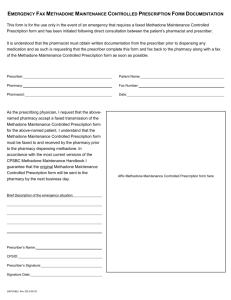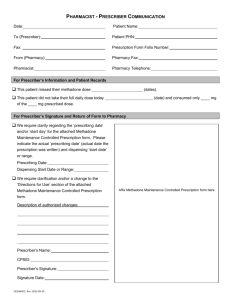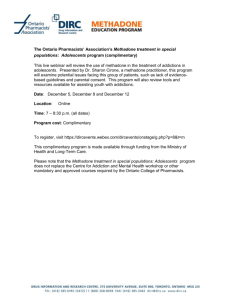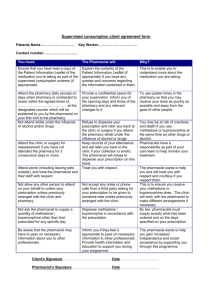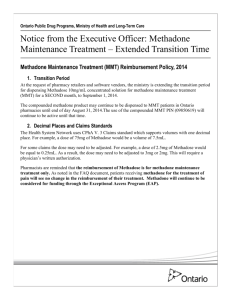PPP-71 Delivery of Methadone for Maintenance
advertisement
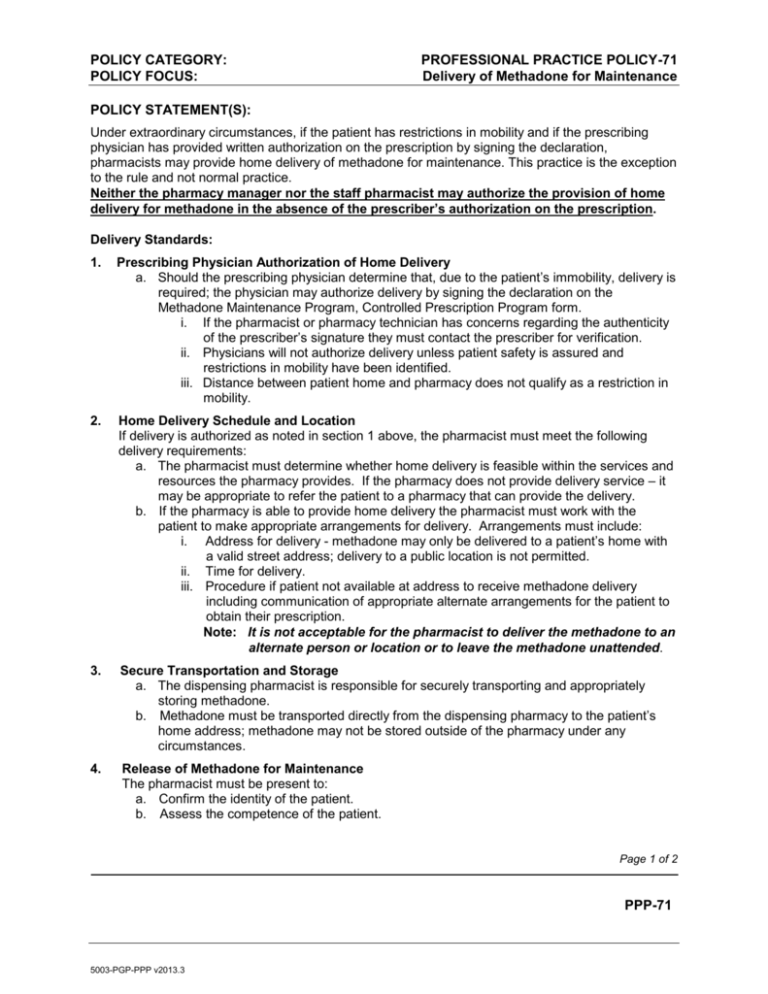
POLICY CATEGORY: POLICY FOCUS: PROFESSIONAL PRACTICE POLICY-71 Delivery of Methadone for Maintenance POLICY STATEMENT(S): Under extraordinary circumstances, if the patient has restrictions in mobility and if the prescribing physician has provided written authorization on the prescription by signing the declaration, pharmacists may provide home delivery of methadone for maintenance. This practice is the exception to the rule and not normal practice. Neither the pharmacy manager nor the staff pharmacist may authorize the provision of home delivery for methadone in the absence of the prescriber’s authorization on the prescription. Delivery Standards: 1. Prescribing Physician Authorization of Home Delivery a. Should the prescribing physician determine that, due to the patient’s immobility, delivery is required; the physician may authorize delivery by signing the declaration on the Methadone Maintenance Program, Controlled Prescription Program form. i. If the pharmacist or pharmacy technician has concerns regarding the authenticity of the prescriber’s signature they must contact the prescriber for verification. ii. Physicians will not authorize delivery unless patient safety is assured and restrictions in mobility have been identified. iii. Distance between patient home and pharmacy does not qualify as a restriction in mobility. 2. Home Delivery Schedule and Location If delivery is authorized as noted in section 1 above, the pharmacist must meet the following delivery requirements: a. The pharmacist must determine whether home delivery is feasible within the services and resources the pharmacy provides. If the pharmacy does not provide delivery service – it may be appropriate to refer the patient to a pharmacy that can provide the delivery. b. If the pharmacy is able to provide home delivery the pharmacist must work with the patient to make appropriate arrangements for delivery. Arrangements must include: i. Address for delivery - methadone may only be delivered to a patient’s home with a valid street address; delivery to a public location is not permitted. ii. Time for delivery. iii. Procedure if patient not available at address to receive methadone delivery including communication of appropriate alternate arrangements for the patient to obtain their prescription. Note: It is not acceptable for the pharmacist to deliver the methadone to an alternate person or location or to leave the methadone unattended. 3. Secure Transportation and Storage a. The dispensing pharmacist is responsible for securely transporting and appropriately storing methadone. b. Methadone must be transported directly from the dispensing pharmacy to the patient’s home address; methadone may not be stored outside of the pharmacy under any circumstances. 4. Release of Methadone for Maintenance The pharmacist must be present to: a. Confirm the identity of the patient. b. Assess the competence of the patient. Page 1 of 2 PPP-71 5003-PGP-PPP v2013.3 POLICY CATEGORY: POLICY FOCUS: PROFESSIONAL PRACTICE POLICY-71 Delivery of Methadone for Maintenance c. Witness the release and ingestion of methadone to the patient, this responsibility cannot be delegated to a pharmacy technician or any other pharmacy support staff. d. Provide appropriate patient counseling. e. If carries are provided, the pharmacist must always witness first dose of the take-home prescription; all subsequent doses must be dispensed in child-resistant containers with explicit warning label(s). 5. Documentation The pharmacist must: a. At the time of release of a methadone prescription the patient and pharmacist must acknowledge receipt by signing a patient/prescription-specific part-fill accountability log. Neither party may ‘pre-sign’ for future doses. b. Document any and all home deliveries of methadone in the patient’s record. c. Log the home delivery with the address where the delivery was made on the methadone part-fill accountability log. d. Document any appropriate follow-up plan in the patient’s record. e. File the methadone part-fill accountability log with original methadone prescription form. BACKGROUND: Legislation Federal legislation does not support delivery of narcotics. The Controlled Drugs and Substances Act (CDSA) defines the transport or delivery of narcotics as trafficking, the Narcotic Control Regulations (NCR) limit the transport of narcotics to licensed dealers only. Controlled Drugs and Substances Act “Section 2 - Interpretation, Definitions1 “traffic” means, in respect of a substance included in any of Schedules I to IV, (a) to sell, administer, give, transfer, transport, send or deliver the substance” Narcotic Control Regulations “Section 2 - Interpretation, Definitions2 “licensed dealer” means the holder of a licence issued under section 9.2. Dealers’ Licenses and Licensed Dealers3 8. (1) Subject to these Regulations, no person except a licensed dealer shall produce, make, assemble, import, export, sell, provide, transport, send or deliver a narcotic.” Pharmacists are required to adhere to the CDSA and its regulations as well as the Health Professions Act, Pharmacy Operations and Drug Scheduling Act and their Bylaws. The College of Pharmacists and the College of Physicians and Surgeons recognize that there are extraordinary circumstances where due to temporary or permanent restrictions in mobility patients would require delivery of their methadone for maintenance to ensure best patient health outcomes and continuity of care. _____________________ 1 http://laws-lois.justice.gc.ca/eng/acts/C-38.8/page-1.html#h-2 2 http://laws-lois.justice.gc.ca/eng/regulations/C.R.C.,_c._1041/page-1.html#docCont 3 http://laws-lois.justice.gc.ca/eng/regulations/C.R.C.,_c._1041/page-3.html#docCont Page 2 of 2 First approved: 21 June 2013 Revised: Reaffirmed: PPP-71
